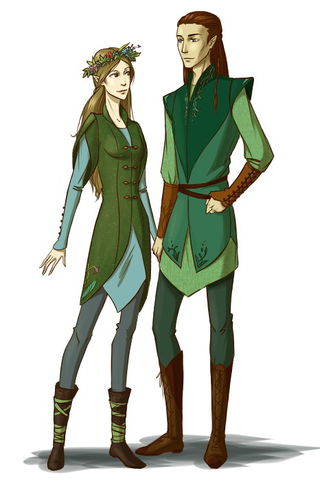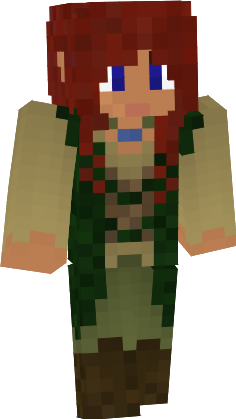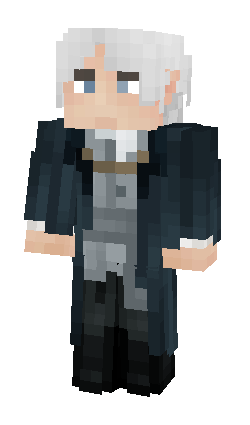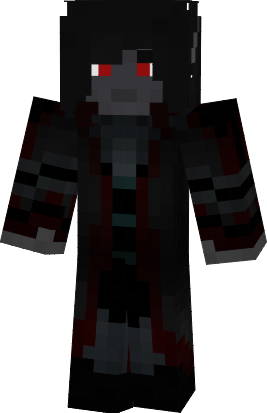Elves
|
|
Elves, also known as Mali in the Elven Language, are the swift footed and keen-eyed inhabitants of many different terrains, cultures, and races. High Elves live chiefly in their Silver City, Wood Elves in the trees within their forests and Dark Elven have caves and other underground places for their homes.
The Elven race is the most longevous of all, some lucky few living well over a thousand years. Although they enjoy longevity, they have the lowest birth rate as a result of Iblees' curse, only reliably fertile for the first five centuries of their lives and with Elves only capable of conceiving about fifteen years after their last Elf-child. This makes pregnant women and expectant fathers a very rare sight, and it is very unusual for more than two siblings to be seen growing together.
Contents
Condensed History
For History Prior to 1300, See: Ancient History
The ancient homeland of the elves was known as the Holy Princedom of Malinor which ruled over the elves for many years. In early Asulon a second Elven nation comprised exclusively of the supremacist high elves known as the Silver Enclave of Haelun'or emerged on the Elven peninsula. After a period of decline throughout Asulon, Malinor was destroyed in Anthos and replaced by the Conclave of Malin while Haelun'or maintained independence.
After years of authoritarian rule, the Conclave of Malin collapsed and through a democratic election, Kalenz Uradir, Sohaer of the Silver Enclave of Haelun'or, came to rule over all the elves for the next few decades in the lands of The Fringe. After thirty years of High Elven rule, the Wood Elves led a revolt that removed Haelun'or from power shortly after the descendants traveled to Athera. After a period of disorder, the State of Laureh'lin rose, led by the orchestrators of the revolution. The government of Laureh'lin deemed the High Elves of Haelun'or and their ideals to be poisonous to Elven kind and so began a genocide against all High Elves they could find.
The High Elves fled their former city, the scattering diaspora taking refuge in an unknown location. Six years after the exodus, the high elves of Haelun'or returned with their reformed armies and newfound allies and threatened to destroy Laureh'lin entirely if their city was not returned to them. Eventually the two nations worked out a compromise with the new leaders of Laureh'lin whereby the High Elves would reclaim their city and the mali'ame would continue to live independently in a separate settlement. A segment of the land that once belonged to Haelun'or was given to the mali'ame to construct a city for themselves which they called Leyulin.
The conflict between the Elves was not yet over. Tensions grew between Laureh'lin and Haelun'or as Haelun'or's Evarir'thilln guard executed increasingly aggressive attacks on the Ivory Order, the guard force of Laureh'lin. Soon the two states reached a level of full-blown conflict. The mali'aheral of Haelun'or invaded the city Leyulin which had been evacuated shortly beforehand. The ensuing battle, known as the "Battle of Leyulin" was ultimately won by the crushing numbers of the High Elves of Haelun'or and Humans of Oren. The Wood Elves, during and after this conflict, retreated across Fiandria Forest to their new city Cerulin which was built in advance knowing Leyulin was likely to fall. A peace treaty pushed by Kalenz Uradir was eventually signed titled the "Treaty of Fiandria".
However, this peace would not last as long, as anticipated. The High Elves of Haelun'or and the Dark Elves of Ker'nor soon created a coalition known as the Emerald Dominion and then proceeded to beckon the Wood Elves of Laureh'lin to join, but on the condition that they remove all impure High Elves from their lands. The State of Laureh'lin refused, and thus the Emerald Dominion proceeded with threats of war. It was only through forceful mediation from the King of Reformed Kingdom of Oren, Andrik Vydra, that saved them from their fate in exchange for Wood Elven vassalisation. In an attempt to bring the High Elves under his control, troops were moved from Oren into Haelun'or, which resulted in the Sillumir of Haelun'or condemning King Andrik Vydra to death by acid. The Dark Elves of Ker'nor soon surrendered, becoming a vassal themsleves. It was Haelun'or which held out for two more years before eventually accepting its fate after a brief war with Oren due to their butchering of their sovereign.
Moving forward, all of Elvendom was now subject to Oren's rule. Oren seemed to support the Wood Elves the most, in a move that caused much dismay and division. This was likely due to a remaining grudge against Haelun'or for their disloyal history. In addition, Wood Elven leaders such as Artimec Camoryn and Tristin Tresury spent many years building rapport with Orenian nobility which would soon pay off. In Vailor Tresury would push for the unification of all elves under one nation - a feat which had not been accomplished in decades. While the High Elves were naturally against joining such a nation, as they wanted nothing to do with the other elves within Laureh'lin, Tresury utilized the looming support of Oren to coerce the High Elven Sohaer, Avern'dionne Adriane, into signing the Treaty of Laureh'lin. This document created the ultimate Elven government titled the Dominion of Malin, placing Tresury as King of all Elven-kind and supreme leader of Haelun'or, Laurehlin, and the Enclave of Ebonglade. The Dominion of Malin was still not entirely independent of Oren, however, and humankind kept the Elves under Orenian rule for years to come.
Haelun'or remained disgruntled with being forced into an alliance with Laureh'lin. Tresury and his closest adviser Artimec seemed to be focused on meticulously and studiously dismantling Haelun'or as a nation. A letter was eventually sent from King Tresury to the Silver Council of Haelun'or in which he admitted his long-held intentions to exterminate the High Elven state. Thus, Haelun'or bode its time and discreetly formed an alliance with Dreadlands and the Kingdom of Courland in a plan to eventually rid themselves of Dominion rule. This alliance, named the Axis Powers, soon declared rebellion against the Holy Orenian Empire as Haelun'or officially severed their connection to Oren and the Dominion. The Dominion, mainly composed by Laureh'lin, remained loyal to Oren as expected. The rebellion failed after numerous battles which forced Haelun'or to sign yet another peace treaty with Oren. Unexpectedly, Oren agreed to let Haelun'or remain independent of the Dominion with the Orenian Emperor condemning the earlier actions of Tresury. Though Haelun'or was free of the Dominion, they were yet again subject to Oren. The Dominion claimed they did not wish for Haelun'or to rejoin the nation in the first place, alleging that Haelun'or was detrimental to Elven unity. Haelun'or viewed this as an advantageous outcome as they were finally separated from the other Elven establishments.
A major world political shift next occurred in Axios, affecting both Elven nations. Rebellion against Oren soon arose with the Courland again leading the charge of a coalition similar to the Axis Powers. Haelun'or initially supported Oren due to the acting leader Orsino Acal’elor being a puppet placed by Orenian leadership. The citizenry of Haelun'or had opposing opinions and, eventually, swiftly removed Orsino and replaced him with a more agreeable representative. This action officially signaled the joining of Haelun'or to the rebellion forces of the Coalition War. The Dominion, as in past wars, remained true to the Empire at the beginning. The leaders of the Dominion remained with Oren far into the war but promptly betrayed their former ally when they realized Oren was heading towards a disastrous defeat. While many did not believe Oren would fall at the beginning of the war, a uniquely fortuitous happened - Courland with the help of the Coalition forces reached the heart of Oren and claimed victory. The Holy Orenian Empire had fallen. Due to this, both the Dominion of Malin and Haelun'or were now truly free from human rule for the first time in decades.
Since then, much has changed within the realm of the elves. Haelun'or has slowly evolved towards a more tolerant approach to other Elven cultures; while the High Elves of Haelun'or continue to pursue their ideal of maehr’sae hiylun’ehya, there have been many attempts by non-Elves to control and vassalize the Silver State. Though, one could say that relations have improved between Elven subraces as the years have passed, many cling to the long-lived hatreds and tenets of racial superiority.
Elves
Elves have long ears, and tend toward fair skin and hair, just like Malin, their forefather. However, their time among nature has molded them toward a wide variety of appearances. Most Elves choose to keep their hair relatively long, with more active individuals braiding it back to keep it from interfering with their work. The length and texture of an Elf's hair usually speaks for their health and vigor, with longer and silkier locks considered almost seductive.
Elves are normally quite tall, usually reaching heights of five to seven feet tall.
Wood Elves
Wood Elves (Elven: Mali'ame) have brown skin, ranging from a light tan to cocoa colored, and are the most likely of all the races to dye their hair green. Though it is usually a shade of dark red, wood elves are often also born as brunettes. On average they are the shortest of the elves, typically slightly smaller than the average human. Their size makes them the most agile and nimble sub-race, making them more suited for quick attacks and escapes in their favoured woodlands when they choose to fight. They live within their sacred forests, many take up druidism, while others simply live our their lives in coexistence with nature.
High Elves
Those of the High Elf (Elven: Mali'Aheral) bloodline can usually be pointed out for their very long ears, light-hued hair, and the golden or silver tint to their fair skin. This tint is complemented by their hair, which is usually blonde, though silver, light-brown, and hair is not unheard of. Their eyes range from hues of green, grey, to blue and, occasionally, even purple. It is also not uncommon for a High Elf's eye color to become darker as they age, revealing the accumulation of wisdom and the emotional weight of long years. They are the tallest of all Elves, and are usually quite slender, making them generally ill-suited for physical combat.
Despite this they often excel at the use of arcane magic, scientific pursuits, and the arts. They often have a strict code which governs their lives, and have some intolerance for impurity and half-breeds.
Dark Elves
Dark Elves (Elven: Mali'Ker) have quite dark skin, especially for Elves, usually twilight grey or obsidian, though rarely dark blue, with hair ranging from pale blue to black, but usually having white or silver hair as well. They are typically between the heights of their taller high elven and shorter wood elven brethren. They are also one of the most muscular elven sub-race, making them the best built for combat and the use of a sword. Though elven eyes are usually purple, blue, or green, and very rarely brown among Wood Elves, in rare cases, the eye color of a Dark Elf may include crimson or violet. They, like the High-Elves, have strict codes governing their lives, often not taking half-breeds into their city.
Aging
Elves develop very similarly to Humans for the first two decades, with both races reaching adulthood near the end of this time frame. Once this point is reached, physical advancement for an Elf slows down so much that it seems as if they aren't aging at all. Elves are also not burdened with the curse of mortality that is present in all Humans, leading to the oldest Elves having an age upwards of eight centuries. While they may be considered immortal by other races and even themselves, there have been cases of Elves dying of old age when they were older than 1000. Due to Elves still being affected by physical harm, such as disease, murder, and internal complications, it is highly unlikely for an Elf to live that long. As of the current date, there are only a few Elves left that are over 1200, as even the oldest Elves alive might not have met Malin, or were quite young when and if it happened. Despite the incredibly long lifespan, their mental progression does not slow. This can be attributed to the fact that "middle age" isn't reached in Elven culture until around five centuries after birth. For this reason, Elves advance their intelligence over many centuries, with relatively young Elves commonly being wiser than the oldest of Humans. Although an Elf reaches physical maturity within a couple decades Elven culture dictates that an Elf is not considered an adult for a longer time, usually half a century to a full century.
An interesting facet about Elven immortality is its eventual toll on the mind, which begins to unravel for Elves who make it to the old age of around a thousand years. As time goes on these Elves enter a state of insanity and lose any sort of mental coherency due to the shear amount of time they have existed. These eldest elves have seen numerous kingdoms rise and fall, dozens of generations of mortal friends perish, and even perhaps their families fading into time. This quite literally causes them to lose their minds.
Language
Despite a common misconception, the majority of Elves have little understanding of Ancient Elven and have instead spoken the Common language for at least four centuries. Why the ancient tongue was abandoned has not yet been revealed, however, it has been speculated to have been deemed an illegal language, thus explaining the difficulty scholars have had in piecing together the ancient language. While steps have been made to educate the next generation of elves on their language of heritage, pronunciation remains the most elusive element and may be the missing link in the forgotten practice of encouraging the growth of nature through whispered words. There are a few living Elves who know the old language and as such it is difficult to piece the language together in modern times and more often than not, words are sacrificed to make way for the modern understandings. The language itself has evolved very little, perhaps this is the reason very few Elves understand it.
Curse
The curse of the Elves is one of infertility, with both male and female Elves suffering its ire; as do all Descendants of Malin, which means half-elves will also inherit this curse.
Despite their curse, it is considered taboo for an Elf under 50 to have a child, as they are not considered a responsible adult until reaching their first half-century. Elven couples will spend many years together before being able to bear a child and pregnant Elven women are treated kindly, almost with reverence, within their communities. Each Elven sub-race has differing traditions or manners of celebrating such a rare occurrence. After giving birth a woman will not be able to have another child for at least fifteen years afterward. When reaching about 500 years old, an Elf(both men and women) will become entirely sterile, never able to have a child again.
Strengths
Blessed with long lives, Elves are sometimes considered the wisest of races, with such an abundance of time to learn from mistakes of their own making and those of others. Elven governments typically revolve around a central executive leader such as a Prince or Sohaer, and a council comprising of bloodlines, clans, tribes or noble houses, which give a voice to the general Elven population. Those Elves who practice skilled labour, a craft or such, often create exceptional works afforded by the time they're able to dedicate to them, and the ample time they have to hone their craft.
| |||||||||||||||




